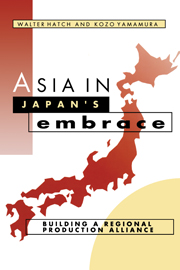Book contents
- Frontmatter
- Contents
- List of Tables
- List of Figures
- Preface
- Part One Co-Prosperity Again
- 1 Crossing Borders: The Japanese Difference
- 2 Flying Geese: An Unequal Alliance in Asia
- Part Two The Embracer and the Embraced
- Part Three A Japanese Alliance in Asia
- Part Four A Powerful Embrace
- Notes
- Select Bibliography
- Index
1 - Crossing Borders: The Japanese Difference
Published online by Cambridge University Press: 05 February 2012
- Frontmatter
- Contents
- List of Tables
- List of Figures
- Preface
- Part One Co-Prosperity Again
- 1 Crossing Borders: The Japanese Difference
- 2 Flying Geese: An Unequal Alliance in Asia
- Part Two The Embracer and the Embraced
- Part Three A Japanese Alliance in Asia
- Part Four A Powerful Embrace
- Notes
- Select Bibliography
- Index
Summary
At corporate headquarters in Osaka, Shuzui Takeo, director of Asian operations for Matsushita, draws a series of little circles on a sheet of paper. Then, with a few quick strokes, he ties the circles together in a grid of criss-crossing lines.
Shuzui is trying to demonstrate how he and his colleagues at Matsushita, the mega-maker of electrical and electronic goods bearing names such as National, Panasonic, Technics, and Quasar, hope to meld the company's 60 manufacturing plants in East and Southeast Asia into a more tightly integrated network. The new approach coincides with a plan by members of ASEAN to gradually reduce duties on products imported by one country from another in Southeast Asia.
“Over the next five years,” Shuzui says, “we must restructure our operations to achieve a kind of intraregional division of labor, or functional specialization. That means concentrating production of single products or parts in different factories in different countries, and exporting most of the output to other markets.”
Malaysia, according to this strategy, might serve as the company's regional production base for air conditioners and refrigerators, Thailand as headquarters for washing machines, Singapore as the center for color televisions, and so on. The ultimate decision on where to locate each production activity, Shuzui says, “would be based on each country's strengths.” If successful, the Matsushita strategy would enable the company's Asian operations to achieve economies of scale, scope, and networking, allowing it to manufacture and export products that could compete more effectively in markets throughout the world.
- Type
- Chapter
- Information
- Asia in Japan's EmbraceBuilding a Regional Production Alliance, pp. 3 - 19Publisher: Cambridge University PressPrint publication year: 1996



